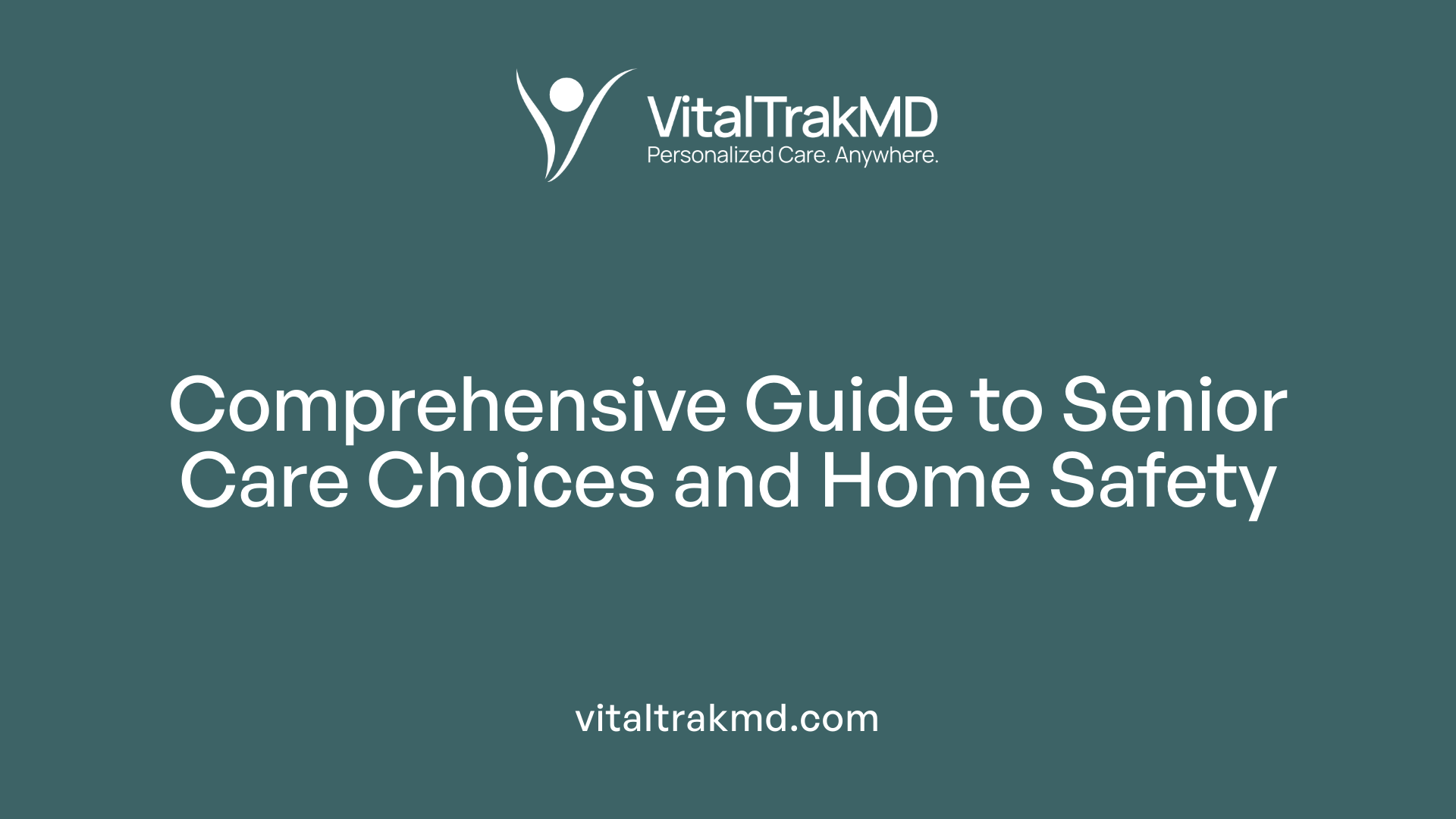Encouraging Elderly Parents to Accept Hybrid Healthcare Services

Understanding the Shift Towards Hybrid Healthcare for Seniors
As the global population ages, the need for innovative, flexible, and person-centered healthcare models becomes increasingly vital. Hybrid healthcare, combining traditional in-person services with telehealth and remote monitoring, offers a comprehensive approach to eldercare that respects autonomy while ensuring safety and continuous health management. Encouraging elderly parents to accept and adapt to these models requires strategic communication, policy support, and a deep understanding of their unique needs and concerns.
Models and Policies Facilitating Acceptance of Hybrid Healthcare in Elderly Care

What are some models and policies that facilitate acceptance of hybrid healthcare services for seniors?
To improve healthcare experiences for seniors, several innovative models and policies have been developed that foster acceptance of hybrid healthcare—combining physical and virtual services. Central to these are patient-centered care frameworks, which emphasize respecting individual preferences, autonomy, and unique health needs. These models focus on involving elderly patients in decision-making and tailoring services to their lifestyles, thus addressing unspoken concerns like privacy, independence, and feeling like a burden.
Integrated healthcare systems are another pillar, providing seamless care that bridges physical clinics, homes, and virtual platforms. These systems coordinate across providers, facilities, and community resources to ensure continuous and comprehensive support. For example, the Southcentral Foundation's Nuka System of Care exemplifies how traditional healing, behavioral health, and community partnerships can work together in a woman-centered model.
Emerging technology-driven models include virtual hospitals and hospital-at-home programs. The Sheba Beyond initiative, for example, leverages remote monitoring devices and telehealth services to deliver hospital-level care directly in patients' homes. Such approaches help seniors feel more comfortable and in control of their care while reducing hospital stays.
Policy measures play a crucial role in enabling these models. Reimbursement policies that compensate telemedicine visits are vital, removing financial barriers and encouraging providers to adopt remote care. Flexibility in care pathways allows health professionals to prescribe and manage treatments through multiple channels. Investment in digital infrastructure, such as broadband access and health IT systems, ensures reliable service delivery, especially in rural and underserved areas.
Health equity policies are designed to reduce disparities in access, ensuring that vulnerable and marginalized populations benefit from hybrid healthcare options. Initiatives that address social determinants of health, provide language and cultural support, and allocate resources to underserved communities help democratize these services.
Finally, fostering interdisciplinary collaboration—bringing together primary care, specialists, behavioral health, and social services—is fundamental to the success of hybrid healthcare. Interprofessional teams can coordinate care plans, communicate effectively, and adapt to changing needs.
These combined efforts aim to create a flexible, accessible, and patient-focused healthcare ecosystem that encourages acceptance among seniors and enhances health outcomes.
Examples of Innovative Healthcare Models and Supporting Policies
| Model/Policy | Description | Impact on Elderly Care | Example |
|---|---|---|---|
| Patient-centered care | Prioritizes individual preferences, autonomy, and personalized approaches | Increases trust, acceptance, and engagement | Elder-centered planning with shared decision-making |
| Integrated healthcare systems | Combines physical, mental, and social services in a coordinated manner | Ensures seamless transitions, reduces fragmentation | Nuka System of Care, Vermont Blueprint |
| Virtual hospitals & hospital-at-home | Remote monitoring and treatment in the patient's home | Comfort, reduced hospital stays, immediate access | Sheba Beyond, remote ICU programs |
| Telemedicine reimbursement policies | Policies that reimburse virtual consultations | Encourages providers to offer telehealth services | Medicare Telehealth Expansion |
| Investment in digital infrastructure | Funding for broadband, health IT, and telehealth platforms | Bridges urban-rural gaps, improves system reliability | Broadband programs in rural areas |
| Health equity policies | Strategies to improve access for underserved populations | Promotes inclusive care and reduces disparities | Medicaid and CHIP programs |
| Interdisciplinary collaboration | Coordinated efforts among diverse healthcare teams | Improves care quality, addresses complex needs | Multidisciplinary clinics |
How do these models and policies support acceptance of hybrid healthcare?
By aligning healthcare delivery with residents' values and ensuring providers are equipped and reimbursed, these initiatives make hybrid care both accessible and desirable. They promote trust, empower elderly patients, and encourage proactive engagement with their health. As digital health infrastructure expands, and policies favor inclusive and flexible care options, acceptance among seniors is likely to increase, leading to better health outcomes and improved quality of life.
Effective Communication Strategies to Engage Elderly Parents in Hybrid Healthcare
What techniques can improve communication with elderly parents regarding their healthcare and independence?
Engaging elderly parents in discussions about their health and independence requires thoughtful communication. Using clear and simple language helps ensure they understand complex medical information without feeling overwhelmed. Face-to-face conversations are often the most effective, as they allow for better reading of facial expressions and body language, which are vital in understanding their emotional responses.
Active listening is another crucial approach. By genuinely paying attention to their words and concerns, you can tailor your responses and build a sense of trust. Asking open-ended questions invites them to express their preferences and fears, making them feel respected and involved in decision-making.
Respecting their autonomy is essential. Even if their choices seem unwise to you, acknowledging their right to make decisions fosters acceptance and cooperation. Avoid patronizing or ageist language that could undermine their confidence or sense of independence.
Supporting understanding with visual aids, such as charts, schedules, or pictures, can significantly enhance comprehension, especially if cognitive or sensory impairments are present. Providing written instructions allows them to revisit information at their own pace.
Sensory impairments like hearing or vision loss are common among older adults. Ensuring good lighting, reducing background noise, and encouraging the use of hearing aids or glasses can improve communication effectiveness.
Creating an environment of empathy, honesty, and respectful dialogue helps to build trust and rapport. Such trust encourages elderly parents to accept help willingly and participate actively in managing their health.
In conclusion, employing these techniques—simple language, face-to-face interaction, active listening, respecting autonomy, visual supports, and consideration of sensory needs—can create a supportive communication climate. This not only improves understanding but also promotes acceptance of healthcare and independence, ultimately enhancing their quality of life and fostering collaborative care.
Educating Families on Senior Care Options and Safety Measures

What are effective ways to educate families about senior care options and safety?
Educating families about senior care options involves offering clear, comprehensive, and accessible information. Families should be introduced to various care choices, such as in-home support, assisted living, nursing homes, and community-based services. Presenting these options in an easy-to-understand manner helps families make informed decisions. Visual aids, brochures, and trusted online resources can be useful tools.
Ongoing conversations are crucial. It’s recommended to discuss elder care early on, ideally before urgent needs arise. These conversations can take place during regular visits or virtual meetings, creating safe spaces for open dialogue.
Questions about safety, independence, and daily routines naturally encourage seniors to express their preferences. Using open-ended questions helps uncover their concerns and goals, fostering collaborative planning.
How can families assess and modify their homes to improve safety?
Home safety assessments are vital in preventing accidents and promoting independence. Families should look for hazards such as cluttered walkways, poor lighting, and unsafe stairs. Simple modifications can make a significant difference.
Installing grab bars near toilets and showers, adding ramps or stairlifts, and ensuring good lighting can reduce fall risks and improve mobility.
Professional safety evaluations are recommended to identify potential issues and suggest suitable adaptations. Local agencies or home modification specialists can provide expert advice.
What community resources and programs support elderly safety and care?
Numerous community programs are designed to assist aging adults. These include home help services, adult day centers, senior care facilities, and transportation assistance. These services support older adults in maintaining independence and participating actively in their communities.
Programs like the Patient- and Family-Centered Medical Home (PCMH) provide continuous, coordinated care involving families, which enhances acceptance and satisfaction. Community organizations often also offer educational workshops, support groups, and health screenings.
Additionally, telehealth initiatives and remote integration models like Project ECHO expand access to specialists and primary care providers, especially in underserved areas. Public insurance options such as Medicaid and CHIP help cover essential health services, easing financial concerns.
How to ensure respect for senior autonomy in decision-making?
Respecting a senior’s autonomy is fundamental. Families should involve elders in every step of care planning and decision-making processes. Explaining options thoroughly and listening empathetically helps seniors feel valued and respected.
Encouraging elders to choose their preferred types of assistance reinforces their independence. Phrasing offers as collaborative suggestions, such as “Let’s try this together,” instead of directives, encourages openness.
When disagreements occur, clear communication and patience are vital. Engaging trusted professionals or family members can facilitate smoother discussions.
Strategies for effective elder care education and safety focus
| Strategy | Description | Benefits | Additional Tips |
|---|---|---|---|
| Early conversations | Initiate discussions about needs before urgent situations arise | Reduces stress, fosters planning | Use open-ended questions, involve elders actively |
| Home safety checks | Conduct regular assessments and implement modifications | Prevents falls, maintains independence | Seek professional evaluations when necessary |
| Community program awareness | Share information about local services and resources | Enhances support network | Attend workshops, use online directories |
| Respectful decision-making | Involve elders in all choices affecting their care | Boosts confidence, respects rights | Communicate clearly, listen actively |
| Use of technology | Incorporate telehealth and remote monitoring tools | Improves access, continuous care | Offer guidance on new tech use |
By combining these approaches, families can ensure that elderly loved ones are supported physically, emotionally, and socially while respecting their independence. Continuous education, safety assessments, and respectful communication are fundamental in fostering an environment where seniors feel empowered and cared for.
Guidance for Caregivers Managing Conversations and Facilitating Acceptance

What practical guidance can assist caregivers in managing conversations and facilitating acceptance of at-home or hybrid care?
Supporting elderly parents as they navigate the transition to at-home or hybrid healthcare models involves thoughtful communication and planning. One effective approach is to establish open and respectful dialogues, ensuring that parents feel heard and valued. Caregivers should actively involve elders in decision-making, allowing them to maintain a sense of control over their healthcare choices. This includes discussing their preferences openly and addressing any concerns about safety, independence, and privacy.
Utilizing telehealth tools can significantly enhance the caregiving experience. Telehealth technologies, such as remote consultations, health monitoring apps, and online support communities, empower both caregivers and elderly individuals by providing accessible, continuous support. These tools promote confidence, reduce feelings of helplessness, and foster a sense of partnership.
Providing tailored psychoeducational resources is vital, especially those that consider the life stage and specific health needs of the elderly. Educational materials and support programs—such as Caregivers FIRST—offer valuable guidance on managing chronic conditions, medication routines, and safety modifications. Flexibility in scheduling and personalized resources help cater to individual needs, making acceptance of care less intimidating.
Supporting caregivers’ own well-being is equally important. Access to mental health resources, caregiver support groups, and respite services can prevent burnout and foster sustained caregiving. Establishing a supportive community culture within healthcare organizations encourages caregivers to seek help, share experiences, and build resilience.
Building trust and confidence requires consistency and transparency. Caregivers should communicate openly about care plans, listen empathetically to elder concerns, and provide reassurance about the quality and safety of services. Over time, these efforts help strengthen relationships, making elderly parents more receptive to assistance.
Incorporating these strategies into caregiving routines fosters an environment of mutual respect and understanding. It encourages elderly parents to accept help willingly, thereby improving their overall safety, health, and quality of life.
Additional Resources and Support Systems
| Resource Type | Examples | Purpose | Benefits |
|---|---|---|---|
| Telehealth Platforms | Telehealth apps, secure messaging | Ease of access to healthcare providers | Reduce travel, support remote monitoring |
| Psychoeducational Materials | Caregiving guides, webinars | Educate about health management | Increase confidence, reduce anxiety |
| Support Networks | Caregiver support groups, online forums | Share experiences, emotional support | Alleviate feelings of isolation |
| Professional Support | Home care agencies, therapy services | Provide specialized care assistance | Enhance care quality, ease burden |
Effective caregiving balances communication, education, and emotional support, leveraging technology and community resources to accept and adapt to evolving care needs.
Recognizing When Elderly Parents Need Help and How to Approach It
How do I recognize when elderly parents need help and how should I approach this?
Recognizing when elderly parents require assistance involves paying close attention to changes in their behavior, health, and daily routines. Common indicators include neglecting personal hygiene, forgetting to take medications, or experiencing weight fluctuations. Mobility difficulties are also significant, such as trouble walking, climbing stairs, or managing household chores.
Behavioral and emotional shifts can be telling signs as well. Watch for withdrawal from social activities, increased irritability, signs of depression, or mood swings. These can suggest underlying mental or physical health issues.
Physical signs like frequent falls, confusion, unexplained bruises, or difficulty eating should prompt immediate concern and possible medical evaluation. These symptoms can indicate health problems or safety risks that require intervention.
Approaching your elderly parents about needing help requires sensitivity. Start by expressing genuine concern in a gentle and respectful manner. Use language that emphasizes partnership and support, such as
Benefits and Practical Considerations for Hybrid Healthcare Approaches
What are the benefits and considerations of hybrid healthcare approaches for elderly parents?
Hybrid healthcare combines traditional in-person medical visits with telemedicine, remote monitoring, and other innovative digital health tools. This approach offers several advantages for elderly parents, primarily enhancing their access to healthcare services.
One major benefit is improved flexibility and convenience. Elderly individuals often face transportation issues, mobility limitations, or live in remote areas where healthcare facilities are scarce. Hybrid care allows them to consult with healthcare providers from home, reducing travel burdens and waiting times.
It also supports aging in place. By using telehealth and remote monitoring devices, older adults can receive continuous supervision and timely interventions without the need to relocate or frequently visit clinics. This helps maintain independence and a sense of control over their health.
Effective hybrid models rely on holistic assessments of the patient's needs and tailored interventions. Comprehensive evaluations can identify specific risks, chronic conditions, and personal preferences, leading to personalized care plans delivered through both digital and traditional means.
From an economic perspective, hybrid healthcare can be cost-effective. It lowers expenses related to transportation, reduces hospital readmissions, and optimizes resource allocation within healthcare systems. Additionally, it supports system efficiency by alleviating capacity constraints, enabling remote specialist consultations, and providing ongoing management of long-term illnesses.
However, there are practical considerations to ensure success. Safety remains a priority, requiring reliable digital platforms, secure data handling, and adherence to quality standards. Technological literacy may vary among seniors; thus, user-friendly devices, clear instructions, and caregiver support are essential. Ensuring equitable access to necessary technology and internet connectivity is also vital to avoid widening health disparities.
Implementing hybrid healthcare models demands proactive planning—integrating suitable platforms into existing clinical workflows and training healthcare staff. It also involves addressing potential barriers like privacy concerns, insurance coverage, and ensuring that caregivers are equipped to support older adults in using these technologies.
In summary, hybrid healthcare offers a flexible, accessible, and potentially more comprehensive care approach for elderly parents. When thoughtfully designed and implemented, it can improve health outcomes, increase caregiver satisfaction, and promote long-term independence.
Addressing Resistance from Elderly Parents to Healthcare or Assistance

How can caregivers effectively address resistance from elderly parents to accepting healthcare or assistance?
Many elderly individuals are hesitant or resistant to accepting help, and understanding how to navigate this resistance is crucial for family caregivers and healthcare providers.
The foundation of overcoming this challenge is approaching conversations and efforts with patience and empathy. Recognizing and respecting their fears—such as losing independence, privacy concerns, or control—is essential. Caregivers should listen actively, validate these feelings, and demonstrate understanding, which helps build a trusting relationship.
Reframing assistance as a way to support their independence rather than diminish it can make a significant difference. For example, describing help as a means to
Creating a Supportive Environment for Acceptance of Hybrid Care

How can I support the autonomy and respect of my elderly parents during care discussions?
Supporting your elderly parents’ independence while ensuring they feel respected is crucial when discussing their care options. Start by involving them actively in every step of decision-making. Offer clear, understandable information tailored to their cultural and personal context about their health and the available care options.
Respect their preferences and wishes by listening carefully and validating their feelings. It’s important they feel heard and valued, which helps foster trust and cooperation. Provide choices whenever possible—this allows them to maintain a sense of control and autonomy. For example, asking, “Would you prefer to try this method or that one?” empowers them to make decisions aligned with their values.
Use person-centered communication strategies to assess their knowledge and decision-making capacity. Being patient and empathetic helps them feel comfortable sharing their concerns and preferences. When necessary, honor any advanced directives or previous wishes through surrogate decision-making, ensuring their past preferences guide current decisions.
To find a balanced approach, you can apply frameworks like the Safety–Autonomy Grid. This helps weigh the safety benefits of certain interventions against their desire for independence, ensuring ethical and tailored decision-making.
Ultimately, creating an open, honest, and respectful environment where your parents feel empowered to participate in their own care leads to better acceptance and preserves their dignity. Building this foundation of trust and mutual respect makes it easier for them to accept help and adapt to health changes.
How can we build trust and rapport?
Building trust over time significantly increases the likelihood that elderly parents will listen to healthcare suggestions. Consistent, honest communication about their health status and care options fosters a sense of security.
Showing empathy, patience, and understanding nurtures emotional bonds, encouraging openness. Small gestures like regular check-ins, active listening, and involving them in community or family activities strengthen these relationships.
How can highlighting benefits and safety reassure elderly parents?
Discussing how new health measures or assistance improve their safety and independence reassures them. Clearly explaining the advantages, such as fall prevention or medication management, addresses fears about losing autonomy.
Using examples from trusted sources or testimonials can also alleviate concerns.
How can personalizing care options help?
Offering a variety of tailored care options early allows your parents to select services that align with their preferences. This could include choosing home modifications, community programs, or healthcare providers they feel comfortable with.
Encourage them to compare options and express preferences, which reinforces their sense of control and reduces resistance.
How do we address fears and misconceptions?
Fears about losing independence or societal stigma may hinder acceptance. Open conversations, gentle education, and involving trusted professionals can dispel myths.
Address specific concerns with empathy and concrete information, emphasizing support rather than surveillance.
How can engaging professionals and community supports help?
Trusted healthcare providers, social workers, and community resources can add credibility and reassurance. Their involvement demonstrates professional backing and offers additional layers of support.
Community programs can provide social engagement, skill-building, and health education, further normalizing acceptance.
| Aspect | Strategies | Examples |
|---|---|---|
| Building Trust | Consistent communication, empathy | Regular check-ins, active listening |
| Highlighting Benefits | Explain safety and independence gains | Fall prevention, medication safety |
| Personalizing Options | Tailor choices to preferences | Home modifications, local services |
| Addressing Fears | Open dialogue, education | Myths about aging, independence |
| Engaging Professionals | Collaborate with trusted providers | Primary care physicians, community centers |
In embracing a holistic strategy that emphasizes respect, safety, and personalization, families can create an environment where accepting hybrid care—combining home, community, and medical support—is a positive, empowering step for elderly parents.
Fostering Respectful and Person-Centered Elder Care
Transitioning elderly parents to accept hybrid healthcare services necessitates a compassionate approach rooted in trust, respect, and personalized communication. By understanding their fears, supporting their autonomy, and leveraging policies and models designed to provide holistic, integrated care, families can create an environment conducive to acceptance. Utilizing technology like telehealth, emphasizing the benefits of remote monitoring, and involving trusted professionals and community resources further facilitate this transition. Consistent, empathetic engagement—coupled with education, safety modifications, and caregiver support—lays a strong foundation for aging in place with dignity and health. Ultimately, fostering mutual understanding and respecting individual preferences ensures that elderly parents feel empowered in their healthcare journey, benefitting both their well-being and the overall quality of eldercare.
References
- 12 Expert Tips: Encouraging Elderly Parents to Accept Help
- Integrated Primary Care Delivery - Implementing High ... - NCBI
- What to do when your aging parents need more care than you can ...
- How To Persuade Elderly Parents To Accept Home Healthcare?
- Health Care Programs and Services - NCBI
- Living with Aging Parents - 6 Tips to Consider Before the Big Decision
- Comparing In-Person Only, Telemedicine Only, and Hybrid Health ...
- Healthcare's Future Is a Hybrid Model - Caregility
Recent articles
Want to Feel Better and Live Healthier?
Join hundreds of patients taking control of their health with personalized care that fits their life – not the other way around.
Rated 4.8/5 by 32+ customers







